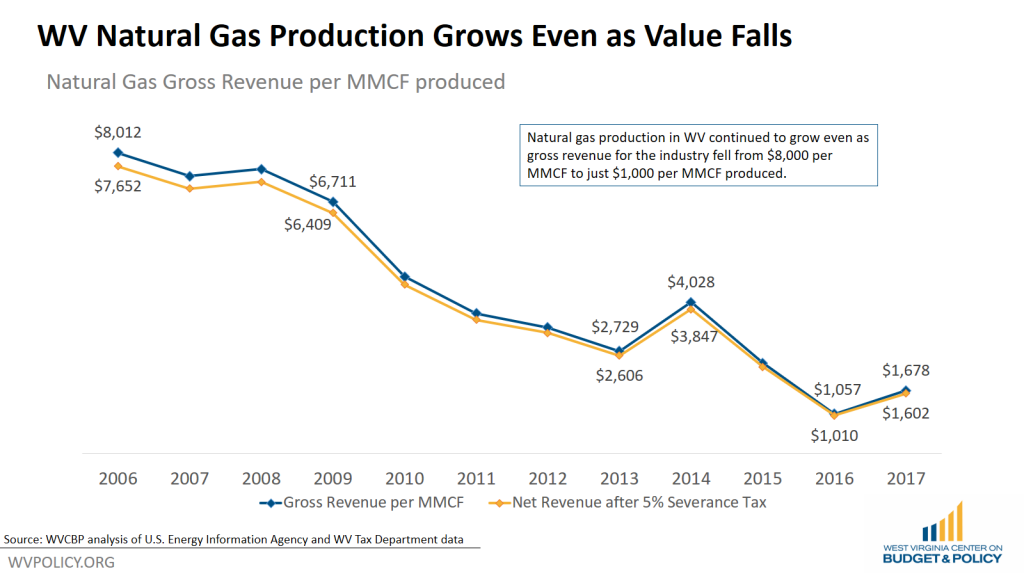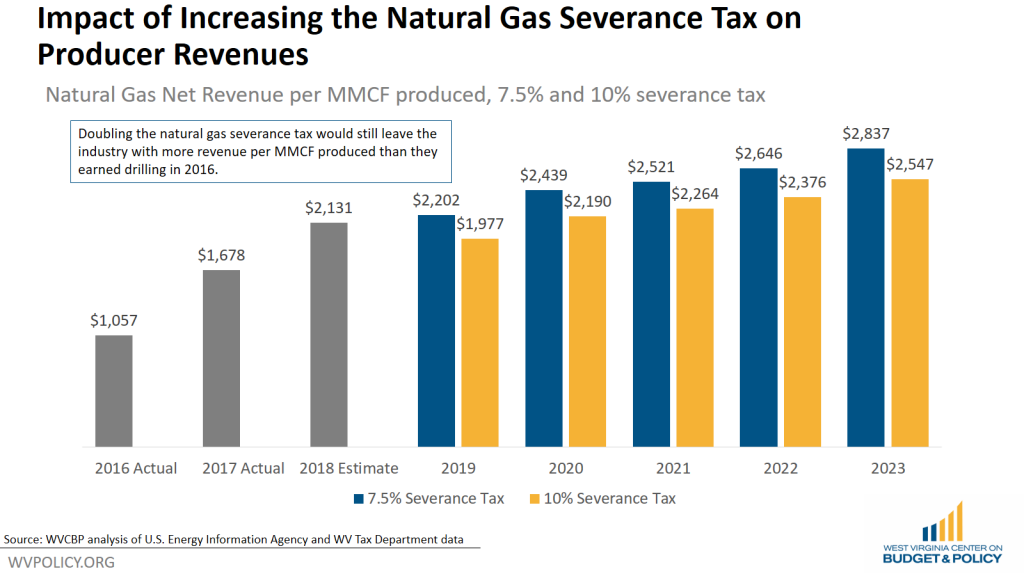Earlier this month, this blog post examined the impact of the booms and busts of the natural gas industry in the counties where it is most active, using some broad economic metrics. As it showed, despite producing billions of dollars in natural gas during the recent boom in production, there hasn’t been a significant impact on jobs, incomes, and population. In fact, one of the only places where one can clearly see an impact from natural gas production is in the severance tax.
As we’ve covered before, the severance tax is one of the most effective ways to ensure West Virginia benefits from its natural resource wealth. As a low-income state that is rich in natural resources, the revenue collected through the severance tax on resources like coal and natural gas plays an important role in funding education, health care, infrastructure, and other services provided at the state and local level.
West Virginia currently levies a five percent severance tax on the value of natural gas produced in the state. Ninety percent of the revenue is used by the state government, while 10 percent is distributed back to county and local governments. In 2017, the state collected roughly $97 million in natural gas severance tax, with $9.7 million distributed to local governments.
With the debate over teacher and other public employee pay and PEIA costs currently ongoing, proposals have been floated to address PEIA costs with an increase in the natural gas severance tax. The natural gas industry has been historically hostile to proposed severance tax increases, claiming last year that a tiered severance tax rate starting a five percent and increasing with price, would “destroy the oil and gas industry.”
Would an increase in the severance tax destroy the gas industry? As the booms and bust update post showed, natural gas production has been growing by leaps and bounds in West Virginia, from 223 million mcf in 2006 to 1.4 billion mcf in 2016, a 520 percent increase. And data from the U.S. Energy Information Agency shows production likely to top $1.5 billion mcf in 2017. At the same time, prices have been volatile, but mostly have fallen, plummeting from $8.69/btu in 2006 to under $2.00/btu throughout 2016.
That means the amount of revenue natural gas producers can generate per MMCF of natural gas produced has also fallen. The chart below shows that, both before and after the severance tax is applied. In 2006, natural gas producers generated $8,012 per MMCF of natural gas they produced. After they paid the severance tax, they were left with $7,652 per MCCF to pay their other taxes, pay employee wages, pay for equipment, and other businesses expenses. By 2013, the after severance tax amount had fallen all the way to $2,606 per MCCF. After rebounding in 2014 to $4,028 ($3,847 after severance tax), it crashed again to just over $1,000 in 2016.

Despite that crash in the value of natural gas produced, production has increased every year in WV. Even between 2014 and 2016, when the value fell by 300 percent, production increased by 48 percent.
So even when the natural gas industry was receiving only $1,000 per MMCF of natural gas produced after paying the severance tax, production continued to grow. Let’s assume that $1,000 per MMCF is the bottom, and that if raising the severance tax drops the per MMCF revenue below $1,000, that would be low enough to cause production to drop and the industry to leave West Virginia. Would an increase in the severance tax drop per MMCF revenue below that level?
According to the FY 2019 budget’s severance tax projections, the governor’s budget office expects natural gas production to increase by 4.4 percent per year from 2016 to 2023. The Tax Department also projects that the state’s share of natural gas severance tax revenue will increase from $99.9 million in FY 2017 to $229.1 million in FY 2023.
At those production and price levels, before the severance tax is applied, natural gas producers would be generating $2,367 per MMCF in 2019, rising to $3,050 per MMCF in 2023, well above 2016 levels. The chart below shows what the after-severance tax value would be for producers, with a 7.5% severance tax and a 10 percent severance tax. And as a chart shows, even doubling the severance tax to 10 percent would leave natural gas producers with over $2,500 per MMCF in 2023, more than 2.5 times the revenue they received in 2016. Even in 2019, with natural gas prices still recovering from their most recent crash, a 10 percent severance tax would leave producers with more revenue per MMCF than they produced in 2016.

Even a modest increase to 7.5 percent, while leaving plenty for the industry, would have a big impact on the state’s finances. Increasing the severance tax rate to 7.5 percent would increase severance tax revenue by $93 million in 2019, and at total $585 million from 2019 to 2023. Increasing the rate to 10 percent would have an even bigger impact, increasing revenue by $186 million in 2019, and a total of $1.17 billion from 2019 to 2023. And the increase in the severance tax would leave natural gas producers with no less than $1,977 per MMCF produced, which again, is well above the amount the received in 2016, when they continued to increase production.